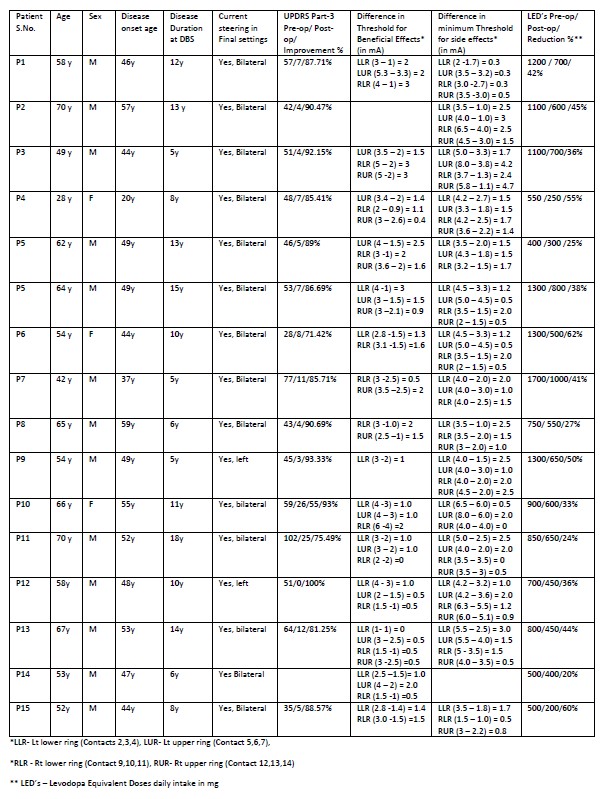Objective: Deep Brain Stimulation using directional leads is relatively recent in India. We present our early experiences with the same.
Background: Deep brain stimulation (DBS) is an approved treatment for movement disorders, including Parkinson disease, dystonia, and tremors. Despite high precision in electrode placement, side effects occur by spread of current to adjacent fibres or nuclei. Directional leads can steer stimulation selectively into any direction, and hence have the potential to optimize beneficial effects and minimize side effects.
Method: We retrospectively analysed 16 patients with Parkinson’s disease who underwent bilateral STN (subthalamic nucleus) DBS using directional leads and an implantable pulse generator (IPG) capable of multiple independent current control. While trajectory planning and most steps of the surgical procedure were same as conventional DBS (ring electrodes) lead implantation, except for fluoroscopic verification of the electrode position with a radiopaque marker. Thresholds for effects and stimulation side effects across the ring and individual electrodes, improvement in UPDRS scores and medication reduction for all these patients were analysed.
Results: Fifteen patients (12 Male, 3 Female) with a mean age of PD onset of 51.7 years (Range 20-70 years) were included in the study. The mean duration of PD at time of DBS was 9.9 years (range 5-13). Threshold of therapeutic benefits and threshold for side effects improved by a mean 1.5 mAmp (range 0 to 4.7) across the different electrode positions when using current steering. The improvement in UPDRS III motor score was mean 87% (range 75- 100) Levodopa equivalent dose reduction (LEDD) was 39.87%. (range 20-60).
Conclusion: Directional leads can adapt the volume of stimulation relative to the position within the target by horizontal current steering directions. Improved thresholds by current steering can improve the therapeutic window in patients undergoing bilateral STN DBS resulting in improved quality of life. When implanted with directional leads, all patients in our series availed of the current steering functionality in at least one electrode.
References: 1. Steigerwald, F., Matthies, C., & Volkmann, J. (2019). Directional Deep Brain Stimulation. Neurotherapeutics : the journal of the American Society for Experimental NeuroTherapeutics, 16(1), 100–104. https://doi.org/10.1007/s13311-018-0667-7
2. Fricke, P., Nickl, R., Breun, M., Volkmann, J., Kirsch, D., Ernestus, R. I., Steigerwald, F., & Matthies, C. (2021). Directional Leads for Deep Brain Stimulation: Technical Notes and Experiences. Stereotactic and functional neurosurgery, 99(4), 305–312.
3. Directional steering: A novel approach to deep brain stimulation, M. Fiorella Contarino, Lo J. Bour, Rens Verhagen, et al. Neurology 2014;83;1163-1169
To cite this abstract in AMA style:
VM. Mathur, PD. Doshi, AA. Aundhkar, MB. Baldia, PW. Wadia. Directional DBS – Early experiences with “Current steering” in India [abstract]. Mov Disord. 2022; 37 (suppl 2). https://www.mdsabstracts.org/abstract/directional-dbs-early-experiences-with-current-steering-in-india/. Accessed December 8, 2025.« Back to 2022 International Congress
MDS Abstracts - https://www.mdsabstracts.org/abstract/directional-dbs-early-experiences-with-current-steering-in-india/

